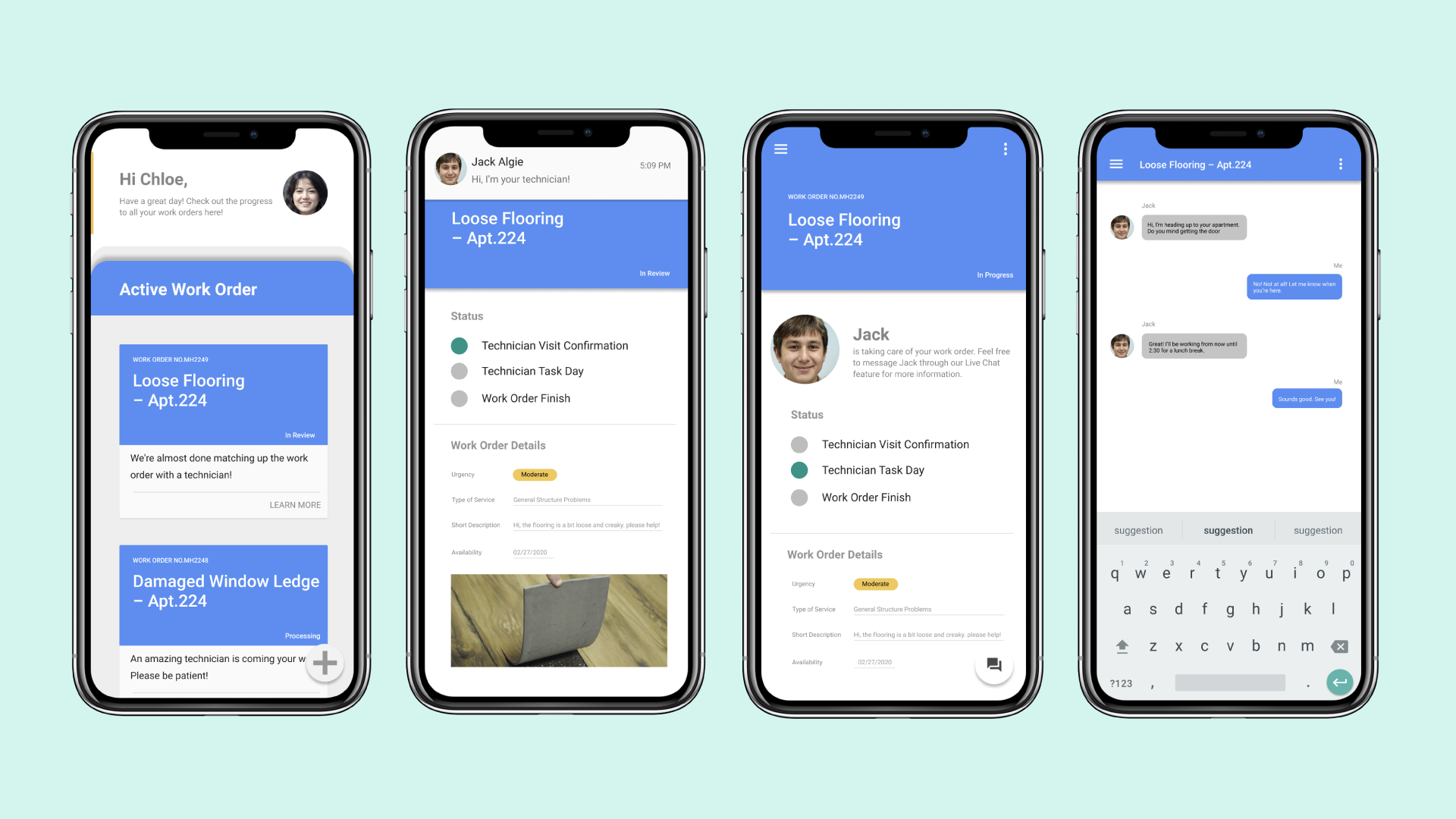MiFacility
MiFacility is an app that aims to ease the process of work order submission on MICA (Maryland Institute College of Art) campus. The app was envisioned to serve on-campus students, technicians, and technician managers.
- Timeline: 1 week
-
Skills: UX research, Flowbuilding, Wireframing, Rapid Prototyping, High-Fidelity Prototyping
- Team: Chloe Phan
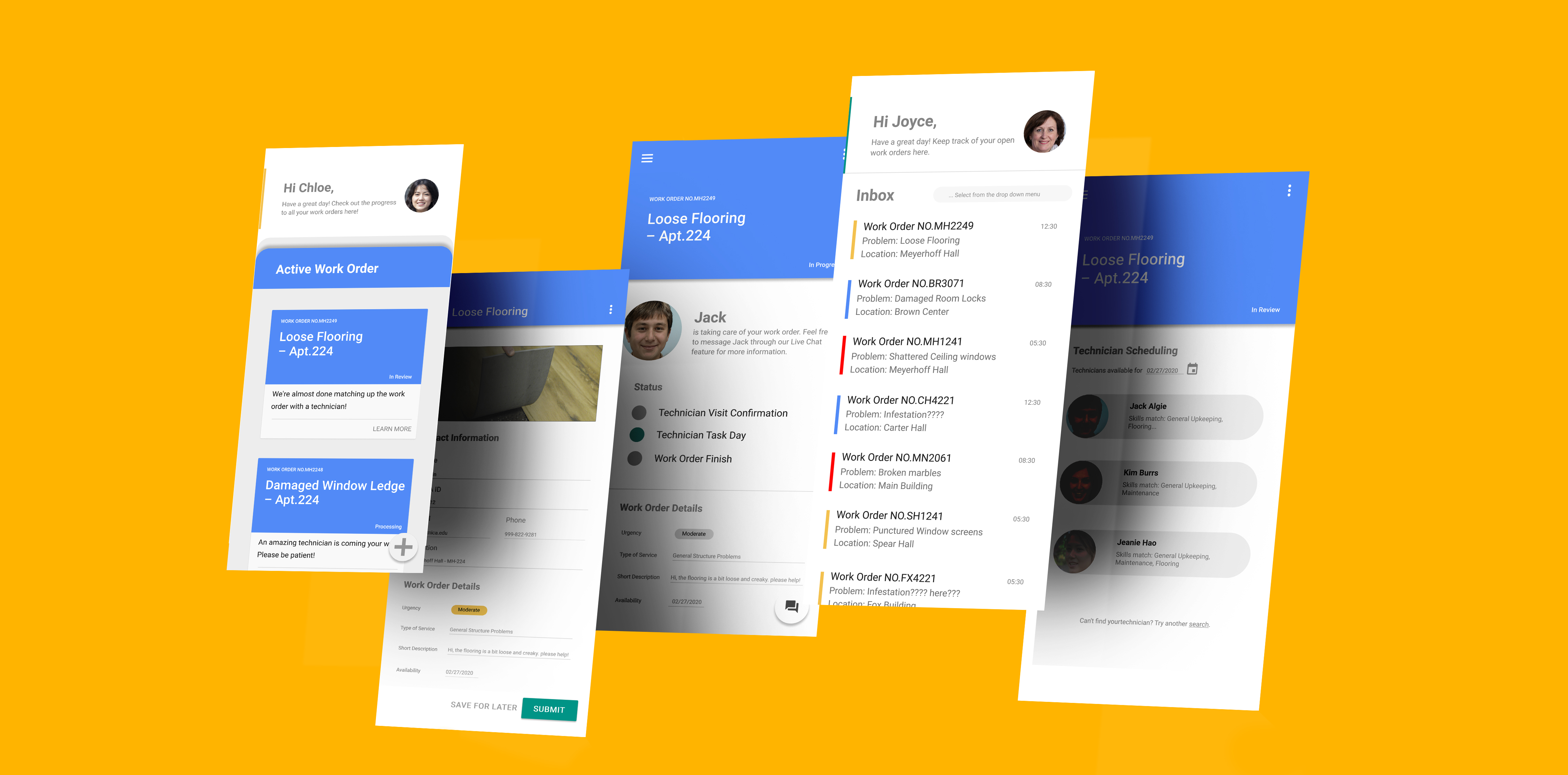
1—Overview
Background
Design Brief
Your school wants to improve the upkeep of campus facilities by creating a new system for reporting any facilities that may need maintenance or repair. Design an experience that allows students to report building or equipment issues on campus. Consider the process of those filing the report and of those receiving and taking action on the issues.
Scope of Work & Explanations
The project had a 1-week timeline, therefore I tried to spread all my process out in that time period. I spent roughly 4-5 hours to figure out my scope for the project, as well as conducting ad-hoc research (interviewing/chatting) that would aid my understanding of the targeted audience. Here are my initial assumptions after considering the constraints of the project:
1. People prefer to file a mobile work order over filing on desktop.
A mobile experience would make it easier for people to report the problem in real time. Bonus if the mobile app has an option for immediate photo reports.
2. People would prefer instant in-app text/chat response over phone calls, long wait times, and delayed email communications.
The mobile app would also function as the main communication channel between my targeted users—it’s immediate, flexible, and removes common interpersonal frictions between requester and provider.
Your school wants to improve the upkeep of campus facilities by creating a new system for reporting any facilities that may need maintenance or repair. Design an experience that allows students to report building or equipment issues on campus. Consider the process of those filing the report and of those receiving and taking action on the issues.
Scope of Work & Explanations
The project had a 1-week timeline, therefore I tried to spread all my process out in that time period. I spent roughly 4-5 hours to figure out my scope for the project, as well as conducting ad-hoc research (interviewing/chatting) that would aid my understanding of the targeted audience. Here are my initial assumptions after considering the constraints of the project:
1. People prefer to file a mobile work order over filing on desktop.
A mobile experience would make it easier for people to report the problem in real time. Bonus if the mobile app has an option for immediate photo reports.
2. People would prefer instant in-app text/chat response over phone calls, long wait times, and delayed email communications.
The mobile app would also function as the main communication channel between my targeted users—it’s immediate, flexible, and removes common interpersonal frictions between requester and provider.
2—Process
Existing Website/Problem
Being a student myself, I ran into some difficulties when trying to submit some work orders. The most glaring one was that the website did not work with all browsers and it can only run properly in Google Chrome. Here are some other issues, both visual and functional, that I collected from my experience with the website:
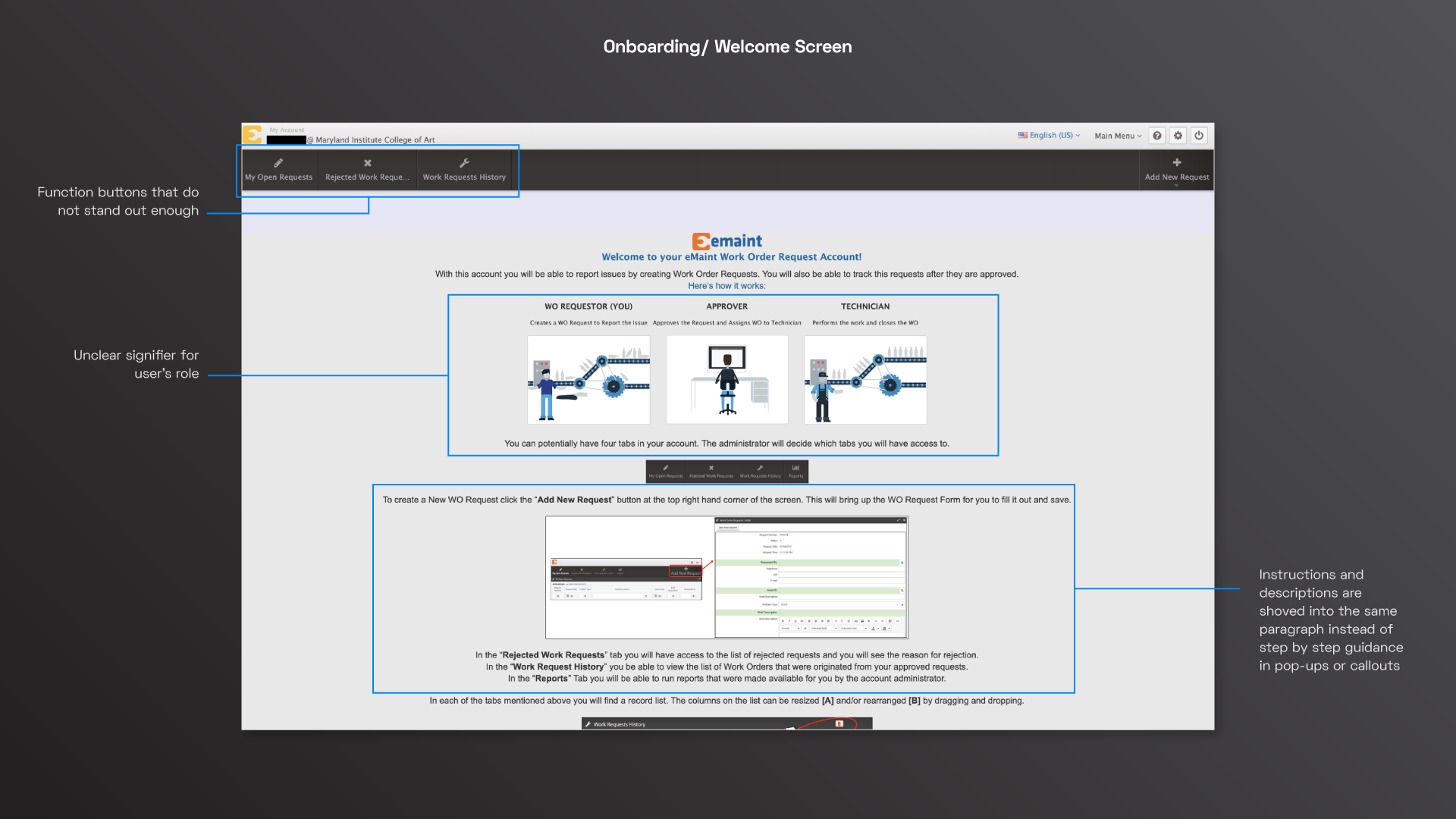
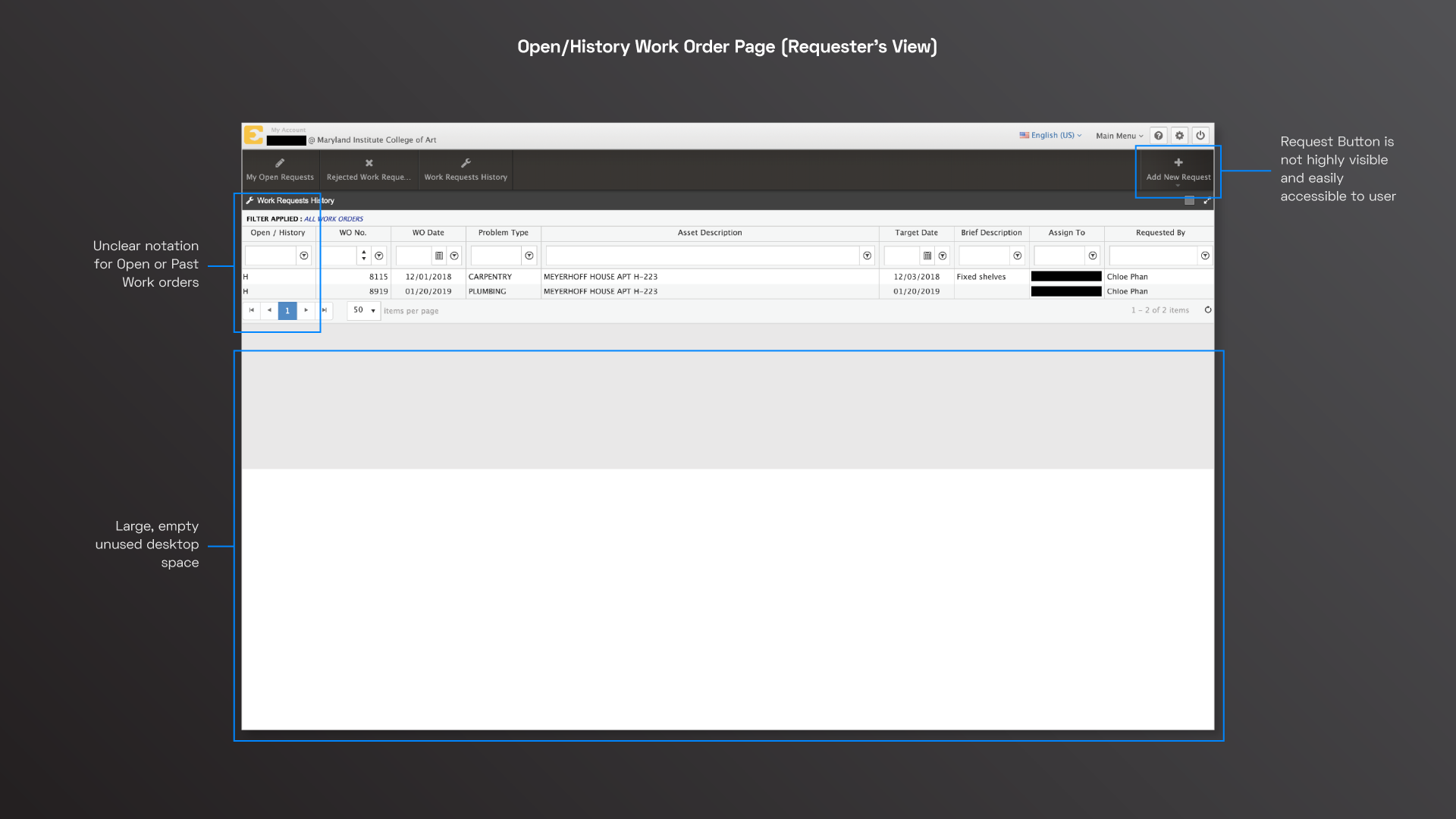

2—Process
Research
Target interviewees/users:
I started by interviewing my peers about their experience with MICA’s maintenance website. The preferred demographics were:
a) students living on campus or
b) students living off-campus but briefly lived on-campus
![]()
I started by interviewing my peers about their experience with MICA’s maintenance website. The preferred demographics were:
a) students living on campus or
b) students living off-campus but briefly lived on-campus
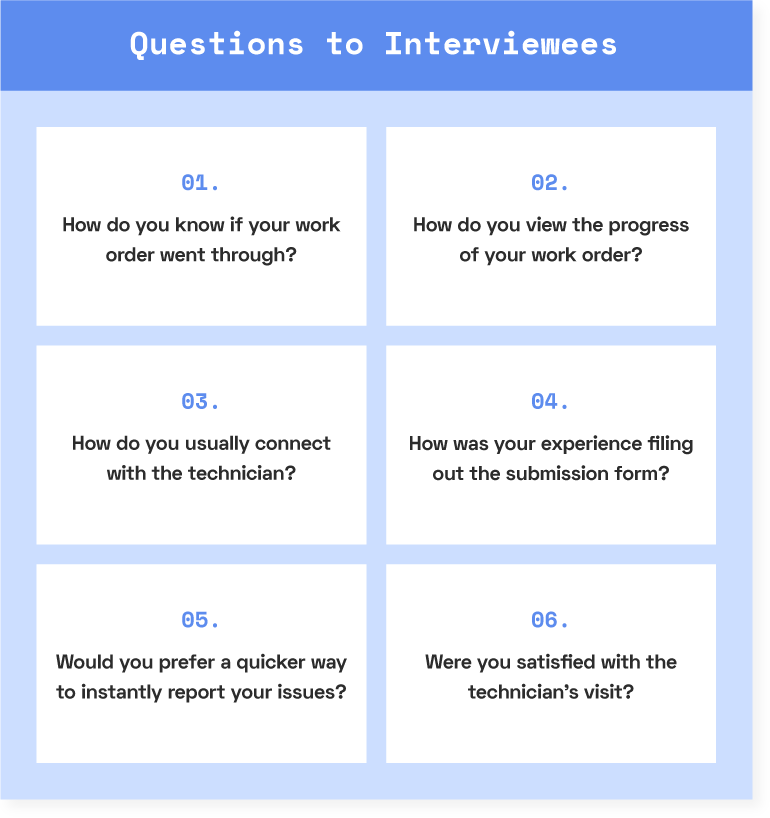
The responses have been helpful in determining why the current website did not work and call for a more user-friendly experience to replace the obsolete site. Below are two target users for the new mobile experience—An on-campus student and a MICA technician:
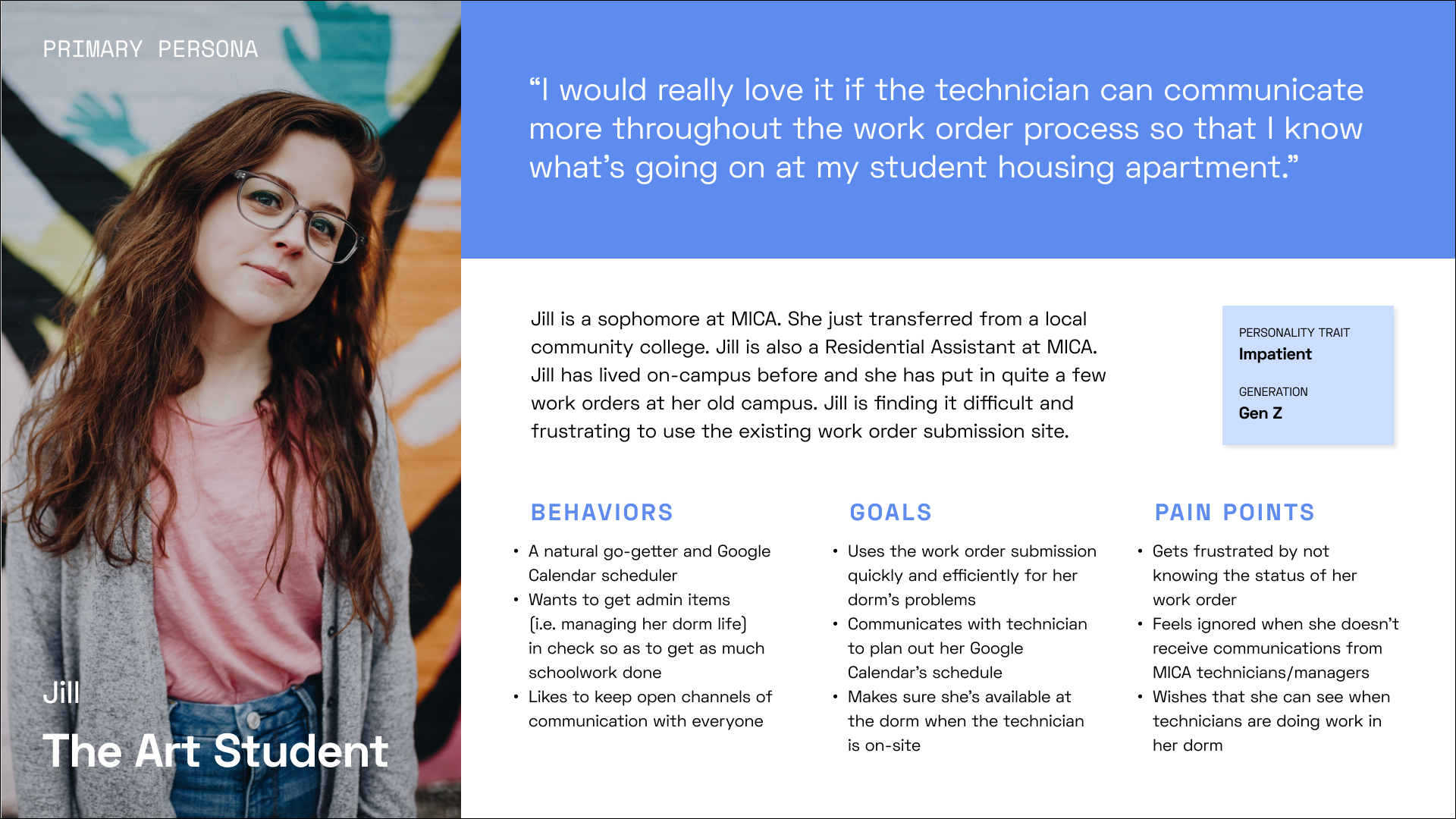
On-campus MICA student

MICA technician
With the previous list of questions and the responses, I added one more assumption and built the connection between issues, assumptions, and possible solutions to this mobile experience:

2—Process
User Flows and Wireframes
Student Submitter Flow

Technician Receiver Flow
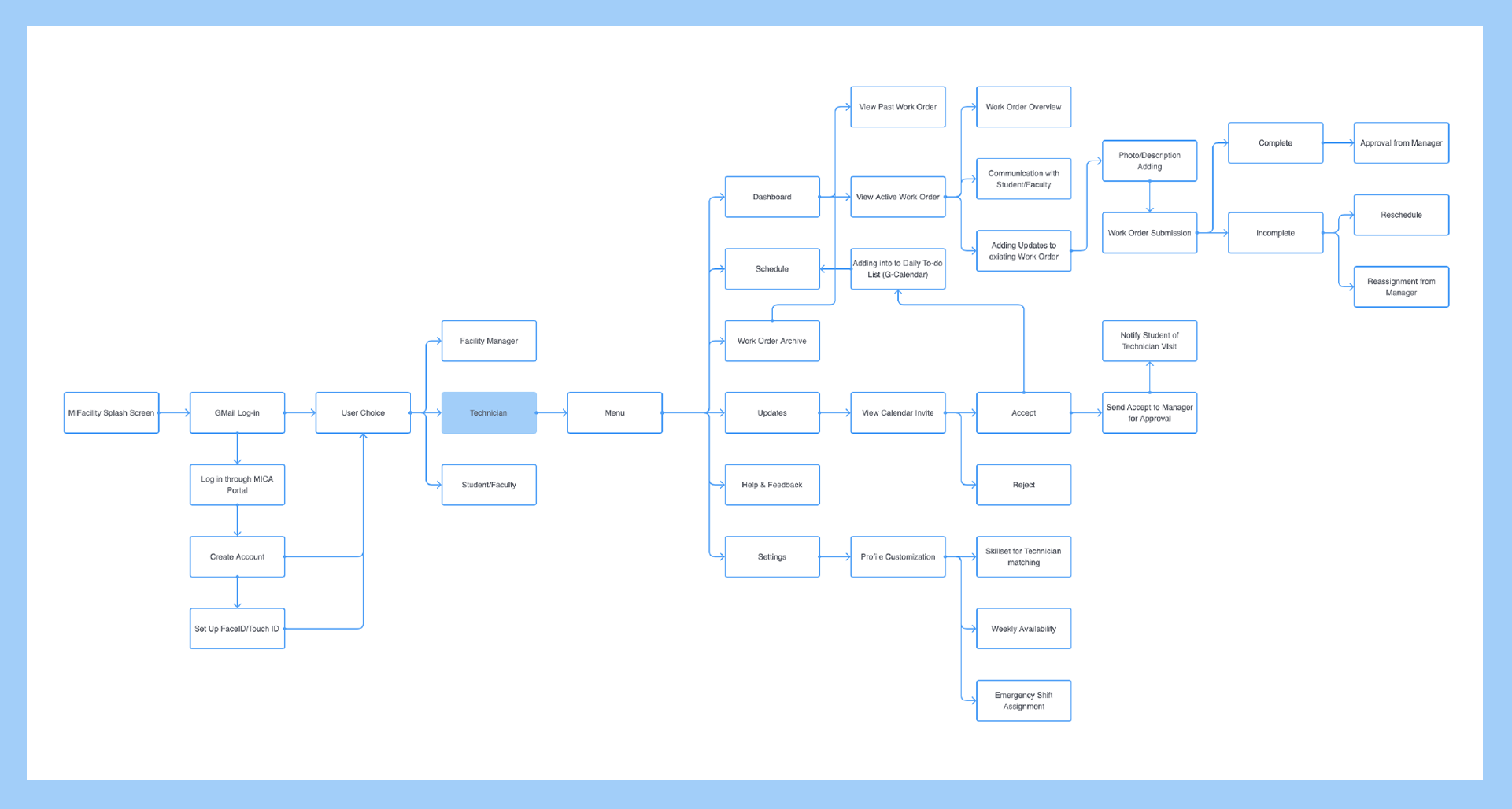
Wireframes
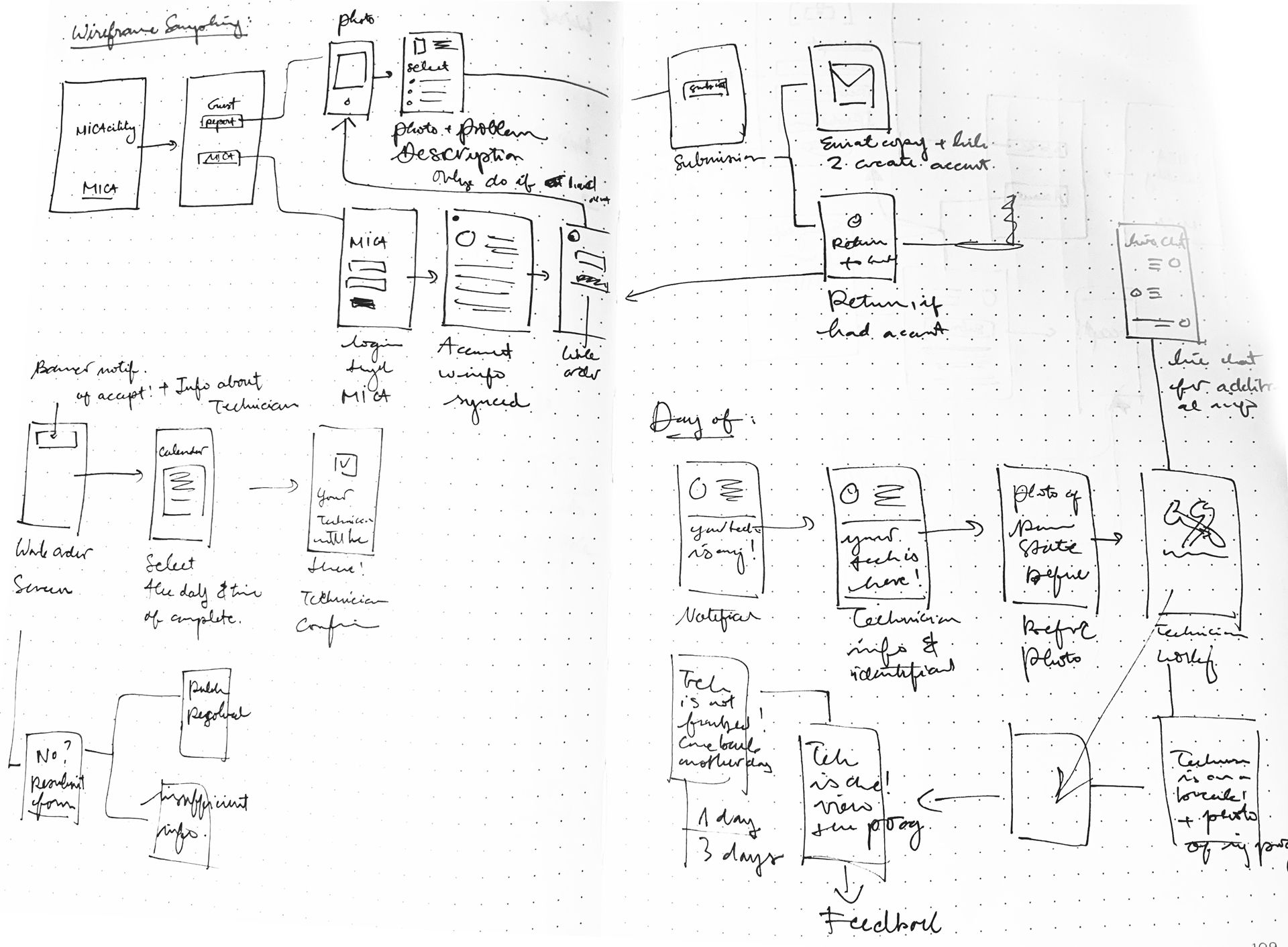
3—Result
MiFacility
Abstract
MiFacility is an app designed for streamlining work order filing process. It aims to provide easier tracking system, simpler administrator interface, and more straightforward and instant communications for easier management.
Design
MiFacility is designed upon the structure of Google Material Design. The color palette is inspired from Google apps and MICA’s official color palette.
MiFacility is an app designed for streamlining work order filing process. It aims to provide easier tracking system, simpler administrator interface, and more straightforward and instant communications for easier management.
Design
MiFacility is designed upon the structure of Google Material Design. The color palette is inspired from Google apps and MICA’s official color palette.
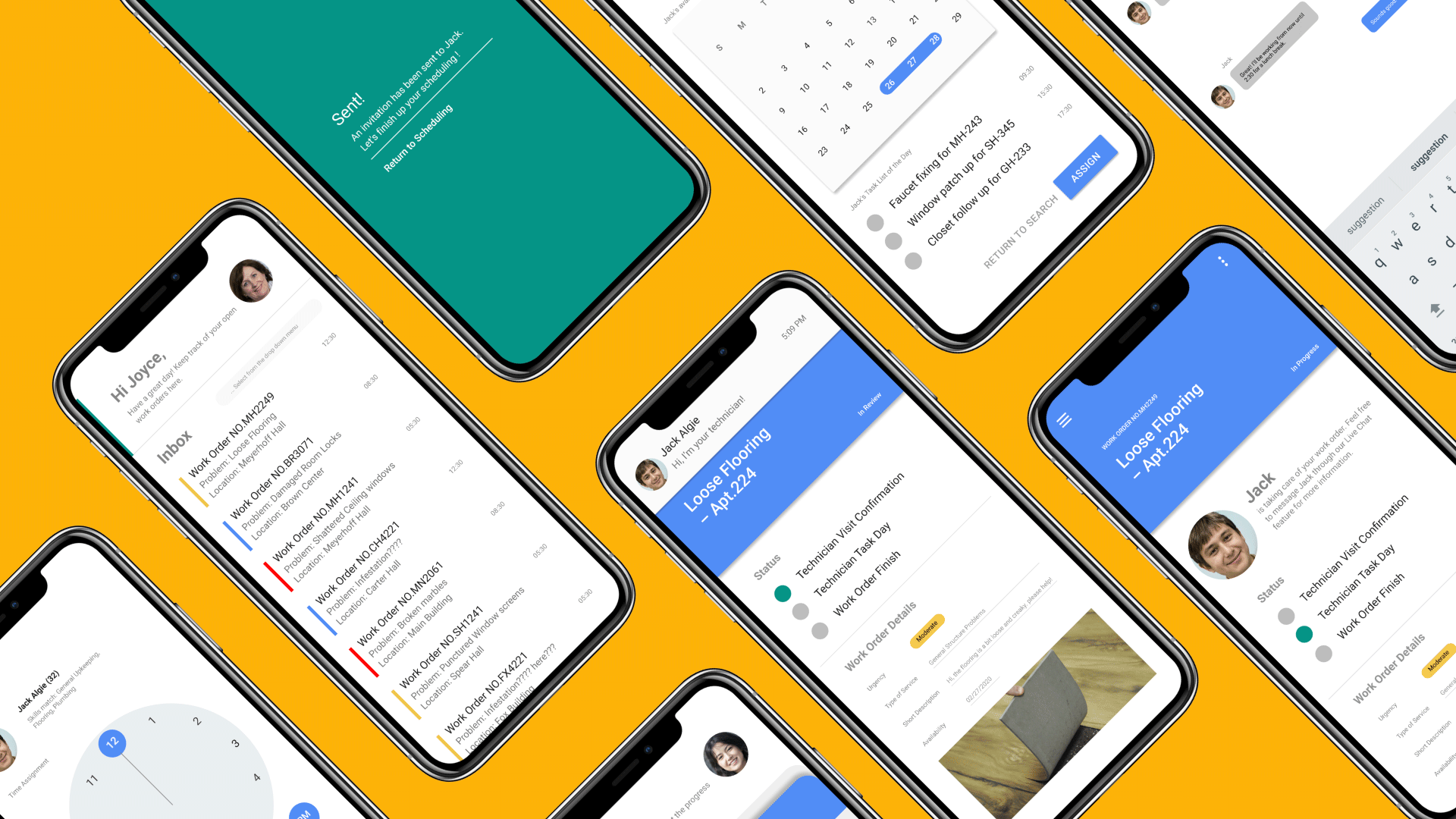
3—Result
MiFacility: Technician Matching
1. Technician Matching
Often times, whenever student have a technician over to perform tasks, they are either stuck with a person who isn’t suitable or who isn’t available to complete the task fully. There was no way to know who would come over and look at their problems. A feature that I wanted to introduce in MiFacility is Technician Matching. Technician Matching would function similar to Google Calendar scheduling or Calendly—When a work order is submitted to the Facility Manager inbox, they will have an option to see who is available at the proposed time and if the person is well suited for the process. These following screens break down this feature:
Often times, whenever student have a technician over to perform tasks, they are either stuck with a person who isn’t suitable or who isn’t available to complete the task fully. There was no way to know who would come over and look at their problems. A feature that I wanted to introduce in MiFacility is Technician Matching. Technician Matching would function similar to Google Calendar scheduling or Calendly—When a work order is submitted to the Facility Manager inbox, they will have an option to see who is available at the proposed time and if the person is well suited for the process. These following screens break down this feature:
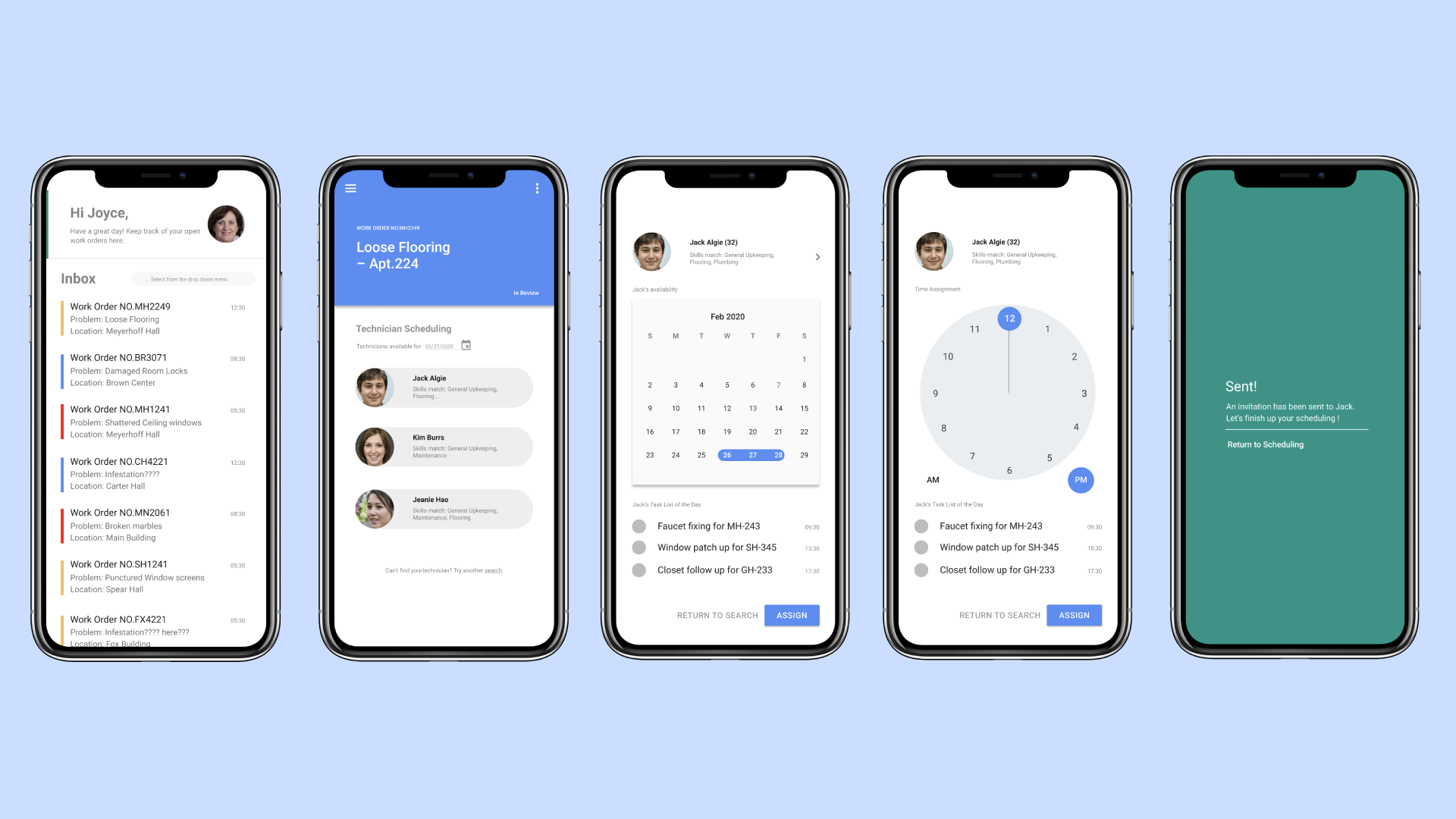
After the facility manager receives a work order request through their inbox (which will be sorted based on urgency), the facility manager can open up their schedule, checks whoever is available at the student/faculty’s proposed date and time, and assign the technician most fitting to the task to perform it. In addition, the process requires both the agreement between the technician and the student/faculty, so as to be carried out successfully. Moreover, the facility manager can see if the technician is maxed out in their daily to-do list, so as to make the tasks easier and more manageable on both sides.
3—Result
MiFacility: Instant Messaging
2. Provider-Requester Communications
In the existing maintenance website, there is virtually no way to communicate with the technician (except for email and very infrequent phone calls.) MiFacility wants to introduce a way to reliably communicate with the technician in real time, and also to track the progress of an ongoing task. In addition, by knowing who’s coming to fulfill your request, the experience can build a sense of trust between the requester and the technician.
In the existing maintenance website, there is virtually no way to communicate with the technician (except for email and very infrequent phone calls.) MiFacility wants to introduce a way to reliably communicate with the technician in real time, and also to track the progress of an ongoing task. In addition, by knowing who’s coming to fulfill your request, the experience can build a sense of trust between the requester and the technician.
3—Result
Future Additions
Features to be included!
• Clustering work orders – based on locations, timing
• Real-time tracking of work order performance
• Flexible scheduling
• Gamification process for performing and submitting work orders
• Clustering work orders – based on locations, timing
• Real-time tracking of work order performance
• Flexible scheduling
• Gamification process for performing and submitting work orders
